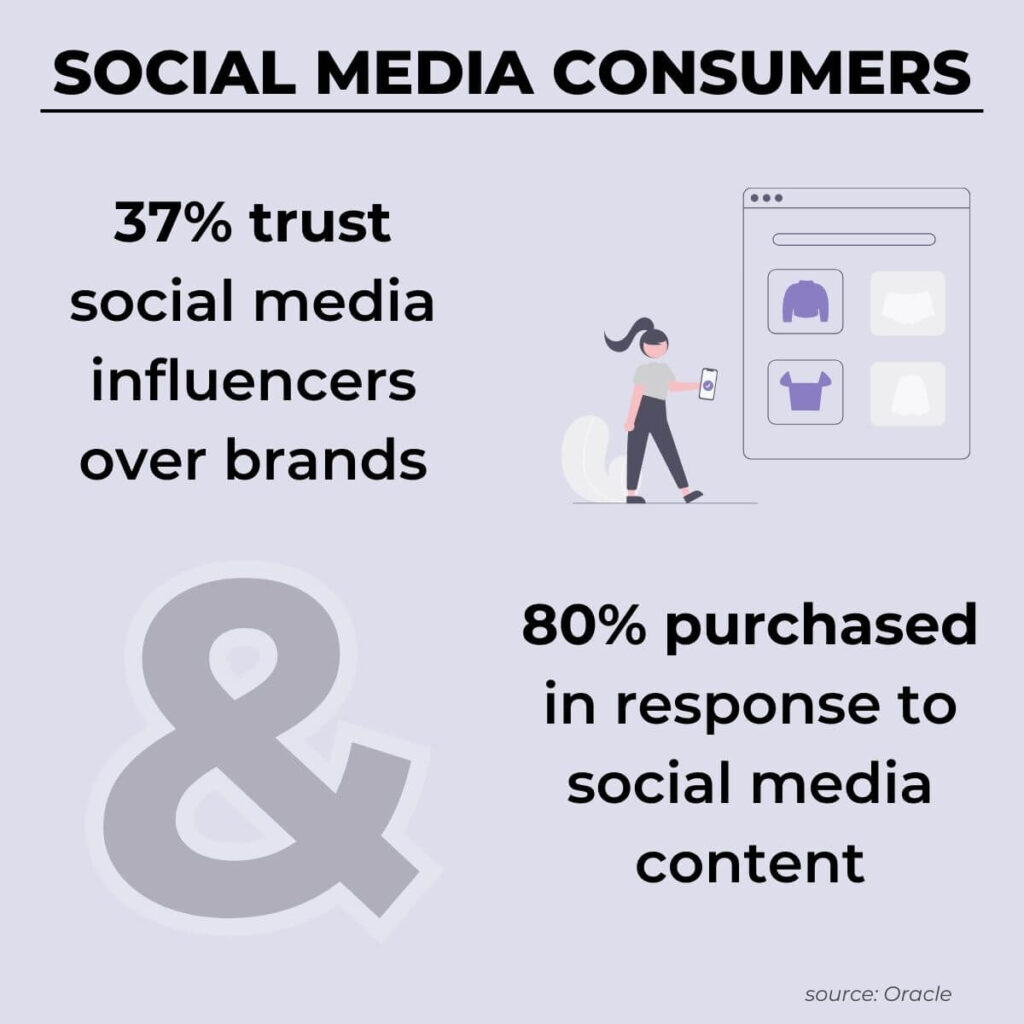UGC for Ecommerce: A Guide for DTC Brands
UGC for ecommerce isn’t an optional or ‘nice-to-have’ tactic for your online store’s marketing strategy—it’s absolutely 100% necessary if you want to compete with (or dominate!) your competition.
A UGC strategy is a huge part of an overall ecommerce strategy and has positive effects on your:
- Website conversion rate
- Digital ad effectiveness
- Social media engagement
In this post we’re going to outline the benefits of UGC for ecommerce, show some examples from top brands, provide some tips on how to source content, and list tools that will help you implement a UGC strategy designed to boost sales for your online store or ecommerce brand.
Let’s get started!
Why use UGC for ecommerce?
Plain and simple, people trust people more than brands. And there’s plenty of research to support this claim. According to a study conducted by Oracle, 37% of more than 2,000 people surveyed trust social media influencers over brands. Additionally, a whopping 80% of respondents reported making a purchase as a direct result of social media content.

Trends in ecommerce marketing come and go, (remember the incredible success of Facebook ads pre-iOS14?) but UGC isn’t just a trend. User generated content is a societal shift driven by technology and connectivity that has irreversibly influenced how we make purchase decisions.
Branding exists to establish credibility, but when you add UGC into the mix, you help your brand bridge the gap between credibility and connection.
And ecommerce brands using UGC to create connections with their customer base enjoy some fantastic benefits.
Benefits of UGC for ecommerce
First things first: What do you, online store owner or marketer, get out of user generated content?
Quite a lot:
UGC establishes trust
According to Nielsen in its global Trust in Advertising Study, 88% of consumers trust recommendations from people they know above all other forms of marketing messages. And in a world connected by social media platforms and live streams, someone you ‘know’ might be an Internet personality.
There are sooo many DTC brands today—Shopify estimates that there may be as many as 110,000 in the U.S. alone—that building trust with your audience has never been more important. The ability to establish trust quickly with an audience (and thus stand out from the crowd of other online stores selling similar items) is the difference between brands that make it vs. those that don’t.
This is why reviews, which are a form of UGC, are so critical to ecommerce marketing campaigns and websites. Speaking of websites…
UGC enhances website conversion rates
According to Salesforce, UGC increases conversions by 10% when included in the online purchase path.
On an ecommerce website specifically, user generated content can take many different forms:
- Reviews: customer testimonials on product pages and pop-ups
- UGC galleries: areas of the site specifically reserved for content from customers
- Embedded social streams: reviews and brand mentions posted publicly to social media platforms
There are plenty of ways ecommerce store owners can leverage user generated content with different effects.
Digital ad efficiency
Not only does UGC help websites convert better, it also reduces the cost of your digital ad campaigns by increasing click-thru rate (CTR) and reducing cost-per-click (CPC).
According to Shopify, ads with UGC receive 400% higher click-through rates, as well as a 50% drop in cost-per-click against the average ad.

Media buyers at DTC brands have been aware of this fact for a few years now and have been using it to great effect. While there are unlimited creative opportunities to repurpose authentic content from customers and fans into digital ads, here are several tried-and-true ad formats:
- Mashup – Combine several different video clips to cover an area of topics. You can often see this type of video using multiple testimonials.
- Before/After – Use video to show how your product transforms the user. *Be especially careful with this video format because Facebook’s ad policies prohibit its use around personal health such as weight loss, exercise, etc.
- Testimonial – Social proof makes a huge impact upon consumer decision-making so you should definitely include some testimonials from your best customers. The more specific, the better.
- Unboxing – It’s like Christmas! For somebody else… However peculiar the trend might be, unboxing videos can be particularly effective UGC, especially when combined with reaction or testimonial videos.
- Product Review – Generally more informative than a testimonial video, a review will give skeptical consumers hard evidence that your product lives up to your claims.
- Hybrid – Cut your video to include still images for added effect. You can combine this tactic with others on the list.
- Text Overlay – Some videos are completely driven by the story that’s told in text. You can see examples of these types of videos on TikTok and Instagram Reels regularly.
Ability to scale creative production
For advanced ecommerce brands that are running sophisticated campaigns, generating enough content to fuel their marketing campaigns across multiple channels can be a challenge. Even for profitable online stores, it’s typically a bit too expensive to have full-time staff for:
- Graphic design
- Videography
- Photography
- Animation
Not to mention the cost of traveling to different locations to conduct video and photo shoots.
Luckily, UGC is the perfect solution to this problem. Today, it’s never been easier to access thousands of creators from anywhere in the world who can provide UGC for your brand. Not to mention that according to the points above, their content created organically will likely perform better on your ecommerce website/in your ad campaigns than anything you could have shot in a studio!
Examples of ecommerce success with UGC
Dr. Marten’s
The famous boot brand went all in on a UGC strategy, pairing their marketing channels with shoppable UGC galleries on key areas of its website—the home page, product pages, and category pages. The results of their efforts were impressive:
- 1.6x conversion rate
- 58% increase in product coverage
- 6 million customer interactions with UGC
Not bad considering they didn’t spend any extra budget on professional photo shoots, opting instead to use their customer base. Smart!
Kettlebell Kings
This fitness equipment brand had tried Google Ads but decided to pivot to Instagram due to lack of results. After a while, the company noticed that its audience and potential customers had begun to produce their own content mimicking the tutorial the brand was putting out.
The marketing team at Kettlebell Kings leaned into this, reposting the UGC and adding call-to-action buttons to their posts on Instagram.
The brand attributes “hundreds of thousands” of dollars in revenue to Instagram and has since crossed the 7-figure mark in annual revenue.
How to source visual UGC
If you’re looking to replicate the results from the brands listed in the previous section, the first thing you’re going to need is the UGC itself—you can’t start running a UGC campaign until you actually have the content in hand.
We’ve written an exhaustive guide on how to put together UGC campaigns (that you should definitely read!), but as an overview here are three great ways to solicit and obtain UGC:
Contests
Contests are an awesome way to source UGC, and they have lots of inherent value, also. This is because not only can you get authentic content directly from your audience, but you also get the engagement and excitement that goes along with a contest.
The only downside to contests is that they are labor intensive to set up. You have to plan for prize fulfillment, create rules/regulations, configure software, and promote it. The results can be worth it, but just know what you’re getting into.
Influencer/creator marketing
Another way to get awesome content is by hiring creators to shoot photos and videos featuring your products. We already covered the different types of video formats that do well on social media, but you can also clip together content from different creators once you have all the assets.
All in all, this is potentially how you’ll be able to get the highest quality UGC—creators make their living shooting content professionally, after all.
The downside is the cost and the fact that this method can also be labor intensive. The process of researching creators, contacting them, negotiating rates, and working with them to the final product can feel like a full-time job; especially if you’re working with multiple influencers.
Earned media
One aspect that not everyone knows about UGC is that, oftentimes, it’s already being created organically and all you have to do is find it. Consumers have a natural inclination to post reviews on products they like and show off purchases they’re proud of.
If you know how to look, you can simply find UGC and reach out to the person who posted it and ask permission to use it—you’d be surprised how many people will be thrilled to have their content featured on your site and/or social media feeds.
If you’re new to the UGC game, starting with claiming your earned media is an extremely efficient method—both in terms of actual cost and time invested. This is exactly why we created Tack. Our tool lets you find content, request permission to use it, and build a media library all in one place. Start a 14-day free trial today!
But let’s discuss a few other tools to get your UGC campaigns up and running.
Tools for ecommerce UGC
Alright, so you’re ready to create a plan to collect user generated content and implement it into your ecommerce business—let’s get you the right tools for the job. Below, we’ve curated a few of our favorite tools for various different aspects of your marketing mix.
UGC for websites
When it comes to increasing the conversion rate of your online store with user generated content, here are a couple tools that can help you get the job done.
Judge.me
Reviews are the ultimate form of social proof, and when you get them, you want to showcase them on your website. Judge.me is a plug-in that works with all major ecommerce website platforms (Shopify, WooCommerce, etc.) and installs in just a few minutes.
With Judge.me, you can not only quickly and easily display your reviews, it also provides tools to solicit and engage with your reviews. Additionally, Judge.me is built specifically with ecommerce in mind and connects with other tools like Klayvio to help you squeeze the most value as possible out of your reviews.
Tack
As we mentioned earlier, showcasing your UGC on your website is a great way to increase your conversion rate and boost sales, but it can also be a pain to constantly be editing your site. With a Tackboard, you can install a widget one time and have it update automatically as new UGC rolls into your Tack account. Of course, you can configure filters so that only approved UGC appears.
Check out a live example of a Tackboard in action on Visit San Diego’s website.

Influencer marketing
Insense.pro
If you’re going to use influencers to create UGC, you’ll need to do two things:
- Find influencers
- Organize your outreach
The good news is that platforms like Insense actually combine these two tasks—they have a marketplace where you can hire vetted creators, and also a CRM to help you manage your outreach and conduct payments. In this way, you can use a single tool to manage find and manage the creators you’d like to hire to fuel your UGC campaigns.
Sourcing UGC
Tack
We said it once but we’ll say it again—if you’re somewhat new to UGC, the quickest and most cost effective (often free!) way to go about acquiring it is to grab the content that’s already out there being posted organically by your fans and customers.
Tack allows you to easily track mentions and requests, and organizes all the UGC you collect into a searchable media library. And most importantly, Tack provides tools to make sure you have explicit permission to use the content you source for commercial purposes, which is the most important part! Get started for free.





